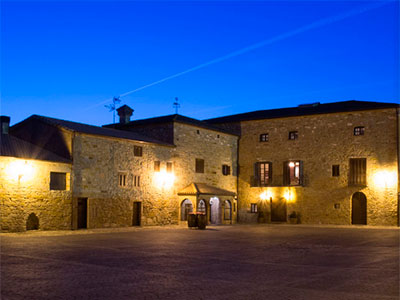Barón de Ley
Carretera Mendavia a Lodosa km 5,5, 31897, Mendavia, Navarra, Spain
www.barondeley.com
Part of the Rioja group Barón de Ley, the parent company incorporates El Coto, one of the largest wineries in the Denomination, as well as Finca Museum in Cigales and Bodegas Máximo, producer of table wines and single varietal bottlings under the VT Castilla category. The group's president, Eduardo Santos-Ruiz, is the main shareholder and controls 90% of the stock.
Barón de Ley is located in Mendavia, within the yet undiscovered Navarra part of the DOCa Rioja. Founded in 1985 with the idea of creating a château-style winery, Finca Imaz started with 90 hectares of vineyards and a 16th century Benedictine monastery which was completely restored and now houses the group's corporate headquarters. The first bottlings were Reserva and Gran Reserva, both launched in the early 1990s. At present, some 4.6 m bottles are produced and its presence is very strong both in the Spanish on-trade and abroad. In fact, 7.95% of all Rioja Reserva wine exports are produced at Barón de Ley, while 6.30% of all Gran Reserva bottles in the world come from the Mendavia-based winery.
Since the turn of the 21st century, the group's policy focused on the purchase and plantings of over 600 hectares of new vineyards. The group owns the largest vineyard in DOCa Rioja (Los Almendros, 300 ha in Ausejo) and properties like Carboneras, in the Ocón valley (Tudelilla), which lies at 850 metres elevation, producing a fresh style that is welcomed at the Mediterranean latitude where Barón de Ley is based. In Arenzana, Alto Najerilla, they also have an important presence with more than 230 ha of Garnacha, Viura and Tempranillo, many of them planted in elevation and over 60 years old. The rest are in Cenicero, where there are some old Tempranillos, and Mendavia.
Minor varieties and white grapes are two strong points. The group has more than 250 ha to tap into Rioja's white potential, including new plantations of Garnacha Blanca and Maturana Blanca in Rioja Oriental. The gradual transformation of the vineyard to organic practices is timidly underway with 40 ha of vines but the winery's idea is to expand this figure to 120 ha by 2025. In the future, Los Almendros will be fully organic.
The arrival of Pablo Tascón as technical director at Barón de Ley in 2019 has meant a boost for the whites. The Rioja-born winemaker, who previously worked for Rafael Palacios, Pazos de Lusco and Dominio de Tares, also prioritizes micro-elaborations (they have more than 200, including reds and whites, ageing in different vessels like oak foudres and cement) and looks for the identity of more special plots, mainly in Najerilla, an area which Tascón knows well after working for white-specialist Nivarius. The wines, which are currently being aged in the winery, will begin to be released in 2023. Among the new wines, a sparkling Rioja blanc de noirs and several singular vineyards will be launched.
The single varietal range -all retailing at around €10-€12 and with productions between 20,000 and 40,000 bottles for Barón de Ley Graciano- includes a serious and balanced Graciano; a perfumed balsamic red Garnacha grown from French clones; a white Garnacha displaying herbs and white fruit aromas; and a Maturana, which highlights the powerful colour, concentration and structure of this grape set to have a great future in the Denomination, specially for its ability to combine power with soft tannins.
That might be the reason behind the change of Barón de Ley Reserva (€10 in Spain) after the 2010 vintage, which include Maturana (7-10%) in the blend, increasing colour, fruit consistency and depth. Above are Barón de Ley Reserva (€18), blends 5-6% Graciano and the premium red Finca Monasterio (€19) with its unmistakeable and flashy gold metal label, sourced from the first vineyards planted around the monastery and featuring Cabernet Sauvignon in the blend, a variety which is “experimental” in the DOCa Rioja. This wine has an interesting bottle evolution, with a good potential for 8-10 years.
The range Viñas includes a barrel-fermented white made from Viura, Malvasía and Garnacha Blanca called Tres Viñas, which shows very good evolution in the bottle, and the unusual and deep Siete Viñas Red, made from all the traditional Rioja varieties. Tempranillo ferments with the whites Viura, Malvasía and Garnacha Blanca whereas Graciano, Mazuelo and Garnacha do it separately. These wines were designed under the oenologic guidance of Gonzalo Rodríguez, who is a consultant at Barón de Ley since early 2000 and works alongside Tascón.
The winery's latest release is Martín Zurbano (130,000 bottles, €9), a red named after a guerrilla fighter and former owner of the estate. Sold only in Spain, it blends Tempranillo from plots in Cenicero and Mendavia and Garnacha from Arenzana and is aged in American and French oak barrels (25% new) for 12 months. Sold in a burgundy bottle and with a gentle fruit-forward profile and creamy oak background, this is Barón de Ley's first foray into the crianza category. The purpose of this wine is to open up new markets, always with the idea of preserving the house's motto of quality and reasonable prices.
In addition to the enormous ageing cellar, the second largest in Rioja with 30,000, 225-litre barrels, Barón de Ley is immersed in the expansion of its bottle cellar, which will have a capacity for 10 m of bottles, as well as new bottling and labelling lines.
Most popular
NEWSLETTER
Join our community of Spanish wine lovers


